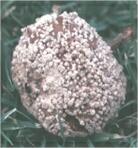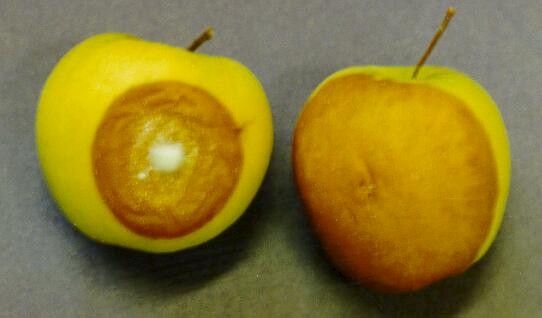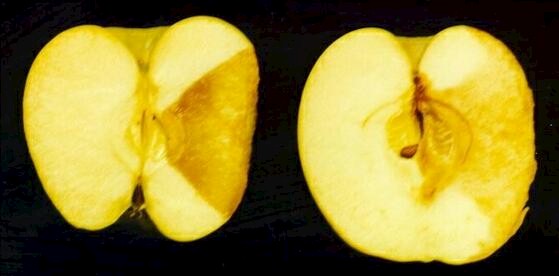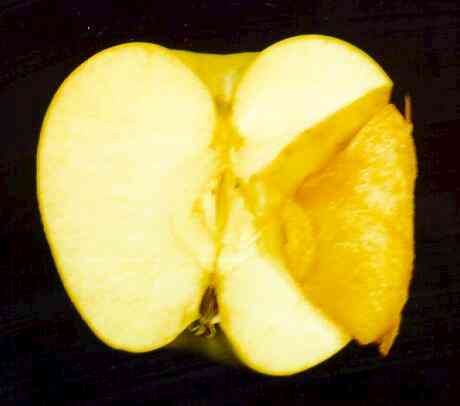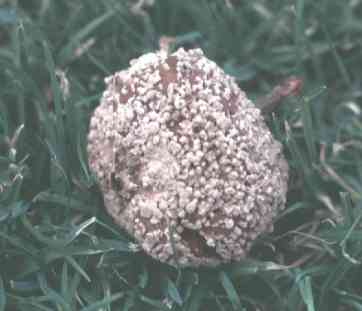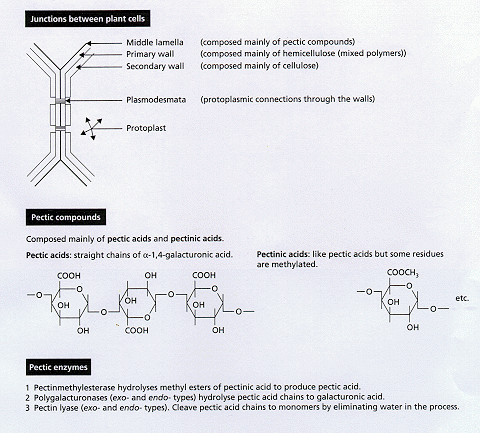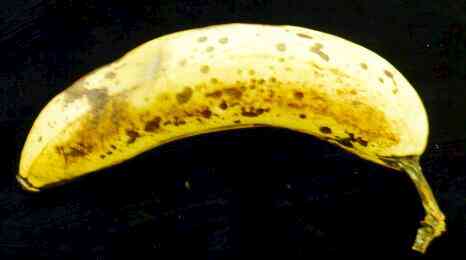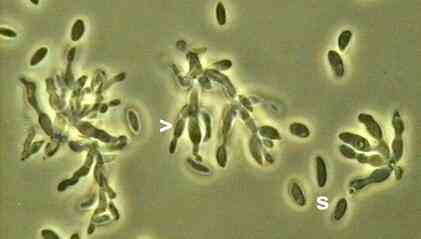Fungi are major causes of plant disease, accounting for perhaps 70% of all the major crop diseases. Some of these fungal plant pathogens are termed biotrophic because they establish an intricate feeding relationship with living host cells (see biotrophic plant pathogens). Others are termed necrotrophic (necros meaning death, trophic meaning feeding) because they invade the plant tissues aggressively, killing the host cells to obtain nutrients. The fungi that cause major damage to stored fruits and vegetables are necrotrophic pathogens. Here we consider three examples:
Apple rot fungi
The image above shows two "Golden Delicious" apples, 6 days after they were wounded by a small cut and inoculated with Penicillium expansum (left) and Monilinia fructigena (right) at the wound point. In both cases the rot has spread progressively, as the fungi invaded the apple tissues and killed them by releasing enzymes. The principal enzymes involved in this are pectic enzymes - those that break down the gel-like pectic compounds that cement the apple cells (or other plant cells) together. There are several forms of these enzymes, but the major one is polygalacturonase (PG), which splits the long pectin chains into smaller units of galacturonic acid.
The image above shows the two apples when cut open. The extent of the rot is similar for both fungi, but the type of rot is quite different. That caused by Monilinia (right) is "dry" and firm to the touch - you cannot squash the rotted tissue easily. In contrast, the rot caused by Penicillium (left) is soft and watery. In fact, as shown in the image below, the whole rotted area separates cleanly from the non-rotted tissue - you can actually remove this rotted area by gently pressing on it with a finger. The difference between these two rots is caused by different activities of the polygalacturonase enzymes of the two fungi. The enzymes of Penicillium completely degrade the pectin.
These two fungi differ in their ecology, and the circumstances in which they cause disease. Monilinia establishes infections in apple orchards, typically through wounds caused by insects or mechanically. Fruit that has fallen and is left on the ground is the source of infection for the next season. It shrinks and mummifies over winter but can produce spores the following season. In contrast, Penicillium expansum is a post-harvest pathogen that infects through wounds caused during handling and packing of the fruit. This explains why we might often see Penicillium rots in shops, but we seldom see Monilinia because the infected fruit is detected and discarded during packing.
The pectic enzymes Both pectin (usually extracted from citrus fruits) and pectic enzymes (from culture filtrates of various fungi) have important commercial uses. Pectin is used for making jams. The pectic enzymes are used to "clarify" fruit juices (e.g. fresh orange juice, apple juice, etc.) by degrading the cementing materials between the cells in the crushed fruit, so that the juice does not contain lumps of tissue.
The pectic compounds and pectic enzymes. Reproduced from JW Deacon (1997) Modern Mycology (Blackwell Science) Anthracnose of bananas The term anthracnose (meaning black coal) is applied to diseases which are seen as spreading black spots on leaves or fruits. A common example is anthracnose of banana, caused by the fungus Colletotrichum musae.
The small, black or brown, slightly sunken lesions of this disease appear only after the fruit has ripened. But the initial infection occurs on the green fruits before harvest, when spores of the fungus land on the fruit surface, germinate and produce a small, localised infection. The infection then remains latent and undetected until the fruit ripens and turns yellow. At this stage the fungus resumes its growth in the skin, and eventually the lesions coalesce, causing blemishes that reduce the marketability of the fruit. Almost any banana bought from a shop will eventually show lesions of this sort, but the process is hastened by damage to the skin during handling and shippage. To help to prevent this, the fruit commonly is dipped in fungicide before shipping. If the fruit is surface-sterilised with hypochlorite and tiny pieces of material are carefully picked from within the brown lesions and placed on agar plates they will give rise to slow-growing, salmon-pink colonies of C. musae. These colonies (see below) contain a mass of fungal spores (conidia) produced from flask-shaped cells (phialides) that arise from multiply-branched clusters of short hyphae.
Botrytis cinerea (grey mould) Grey mould is a very common spoilage disease of soft fruits such as strawberries, raspberries and grapes. It is seen as a powdery grey mass over the fruit surface, and it spreads rapidly, causing extensive rotting of the fruit. The fungus that causes this, Botrytis cinerea, also is a major cause of damage to cut flowers. B. cinerea is classed as a weak parasite, because it has little ability to overcome the normal defence mechanisms of healthy plant tissues. However, in moist conditions it rapidly invades wound sites or senescing tissues (e.g. the dead flower remains) from its abundant airborne spores, and then secretes pectic enzymes that extensively degrade the fruit or other soft tissues.
"It only takes one rotten apple..." Most people have heard this statement. It relates to the fact that senescing plant tissues generate ethylene, and ethylene is a ripening agent. [In fact, bananas are shipped while green, to preserve them in good condition, and then are treated with ethylene to induce ripening before they are sold.] The damage caused by fruit-rotting fungi in even a single fruit in a package leads to the generation of ethylene and thus to the premature ripening of the other fruit. Since all these fruit-rotting fungi are weak parasites, requiring the fruit to be ripe (or over-ripe), a single rotten fruit can lead to a chain reaction. The pectic compounds and pectic enzymes. Reproduced from JW Deacon (1997) Modern Mycology (Blackwell Science) |
